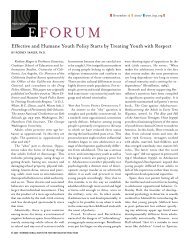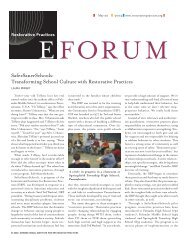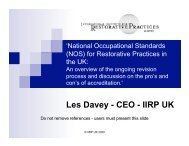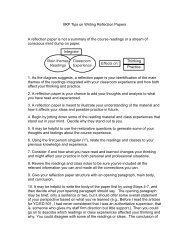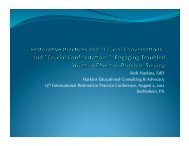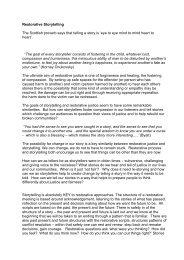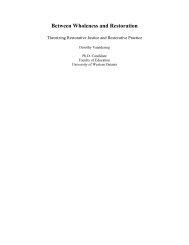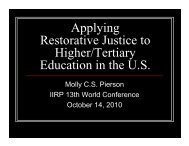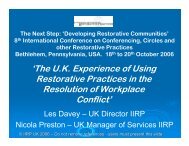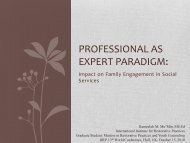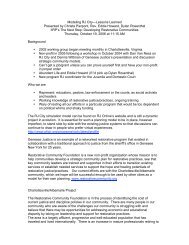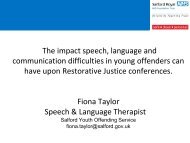Restorative Justice Practices of Native American, First Nation and ...
Restorative Justice Practices of Native American, First Nation and ...
Restorative Justice Practices of Native American, First Nation and ...
You also want an ePaper? Increase the reach of your titles
YUMPU automatically turns print PDFs into web optimized ePapers that Google loves.
<strong>Restorative</strong> <strong>Practices</strong>E FORUM“In the work with the court systemwe’ve developed an informal protocol,although we’re working on a formal one,where we ask for an adjournment <strong>of</strong> fourmonths, <strong>and</strong> we present an interim treatmentplan at that time. It’s a time for usto assess whether the person is actuallycommitted to a healing process <strong>and</strong> forthe person to see if this is the path theywant to take. The interim treatment planinvolves assessment, therapy <strong>and</strong> counseling<strong>and</strong> is unique to each person.”The healing process consists <strong>of</strong> teamcounseling with the individuals thatare involved—those that have harmed<strong>and</strong> been harmed—in preparation for acircle that includes family <strong>and</strong> the widercommunity. Individuals invite their supportersto the circle, but anyone in thecommunity who wants to participate canattend. “We send a flier to every home inthe community,” said Christine Douglas,clinical manager for Mnjikaning Community<strong>and</strong> Family Services, <strong>of</strong> whichBiidaaban is a component. (Christine<strong>and</strong> Leanne Douglas are not related; theirhusb<strong>and</strong>s are distant cousins.) Attendanceat circles is generally 20 to 25 people.At the community gathering, everyoneintroduces themselves <strong>and</strong> sayswhy they’re there. Next, the people whocommitted the wrong talk about what theydid <strong>and</strong> take responsibility for it. Theneveryone has a chance to talk about whatthe impact <strong>of</strong> the wrongdoing has beenon them. The person then apologizes<strong>and</strong> everyone talks about what needs to bedone to make things right <strong>and</strong> to restoreharmony <strong>and</strong> balance. A communityhealing plan is developed <strong>and</strong> a contractis signed by the person who has harmed<strong>and</strong> the Biidaaban team. The gatheringends with a ceremony. Regular meetingsbetween the Biidaaban team <strong>and</strong> thosewho were involved monitor whether thecontract is being fulfilled. A ceremonialcelebration follows successful completion<strong>of</strong> the Biidaaban process.May 26 2004“When you go to the courtsystem, people in thecommunity really don’t knowwhat’s going on there. Butwhen it’s public <strong>and</strong> in thecommunity then everybodyknows <strong>and</strong> it can act like acommunity watch program.”—Leanne DouglasOut <strong>of</strong> over 80 people who have participatedin the process, only four havere<strong>of</strong>fended <strong>and</strong> only one has committedthe same crime: an assault. The otherthree were recharged with breaches <strong>of</strong>probation due to drinking. “It’s a lotbetter than what the justice system’s statisticsare,” said Leanne Douglas. “Whenyou go to the court system, people in thecommunity really don’t know what’s goingon there. But when it’s public <strong>and</strong> inthe community then everybody knows <strong>and</strong>it can act like a community watch program.So people know that people arewatching them <strong>and</strong> that they need to behaveproperly.” Said Christine Douglas,“Our probation <strong>of</strong>ficer said that whenshe first started to come here, close to thebeginning <strong>of</strong> this program, she had 26probationers. Today she has six.”The court system has received theprogram very well. “We’ve developed awonderful working relationship over thelast several years,” said Leanne Douglas.“It was very difficult at first. It took alot <strong>of</strong> education <strong>and</strong> discussions aboutwhat we were doing, <strong>and</strong> probably inthe beginning they were very reluctant,but I think we’ve proven our credibilityto them. We’ve had cases where peoplehaven’t done very well <strong>and</strong> we’ve turnedthem back to the court system. I thinkdoing that has boosted our credibility,www.restorativepractices.orgbecause they know that we’re not goingto say that people are doing well if they’rereally not. But we always have to do ongoingeducation, because every year a newCrown Attorney [government prosecutor]is appointed.”It took several years to develop theBiidaaban model, said Stephanie S<strong>and</strong>y,Mnjikaning <strong>First</strong> <strong>Nation</strong> social servicesworker. <strong>First</strong>, a core group <strong>of</strong> communitymembers researched their people’s history,then received restorative justice trainingfrom Dr. Ed Connors, a psychologist<strong>of</strong> Mohawk <strong>and</strong> Irish descent. They alsovisited Hollow Water, Manitoba, Canada,which had successfully used healing circlesto cope with a legacy <strong>of</strong> child sexual abuse<strong>and</strong> alcohol addiction. The Mnjikaningdecided to base Biidaaban on HollowWater’s healing model. (To read aboutthe Hollow Water Community HolisticCircle Healing Project, in a paper by one<strong>of</strong> its initiators, Berma Bushie, pleasego to: http://www.iirp.org/library/vt/vt_bushie.html.)The core <strong>of</strong> the Biidaaban model is thesame as Hollow Water’s, said ChristineDouglas, but they adapted it. HollowWater is a small, isolated community innorthern Manitoba, while Mnjikaning,she said, is “very much part <strong>of</strong> southernOntario, which is a very populatedarea.”Since 1996, Mnjikaning has been thesite <strong>of</strong> Casino Rama, one <strong>of</strong> the biggestcasinos in Canada, <strong>and</strong> the largest employer<strong>of</strong> <strong>Native</strong> people in the countryin a single venue. With 12,000 peoplefrequenting it daily, the casino has completelytransformed the community.“Our unemployment rate before thecasino was 65 percent <strong>and</strong> that was aftera lot <strong>of</strong> hard work to get it down to 65percent. Now it’s about 10 percent,” saidChristine Douglas. A l<strong>and</strong> lease <strong>and</strong> directpayments from the casino provide forinfrastructure such as water <strong>and</strong> waste watertreatment <strong>and</strong> police <strong>and</strong> fire fighting© 2004 INTERNATIONAL INSTITUTE FOR RESTORATIVE PRACTICES 53⁄4



